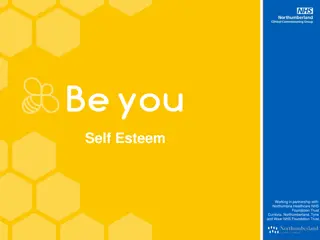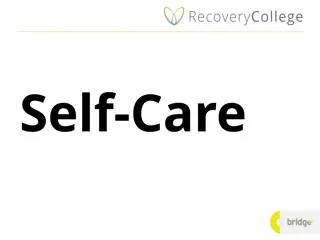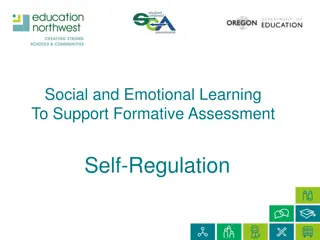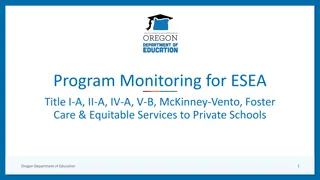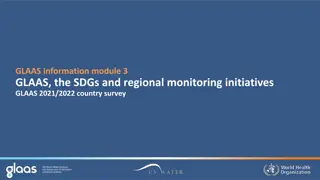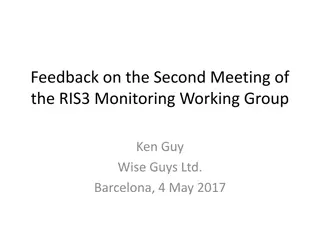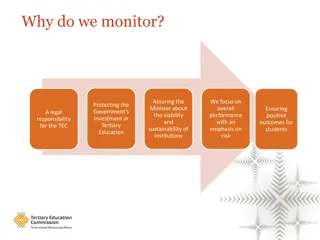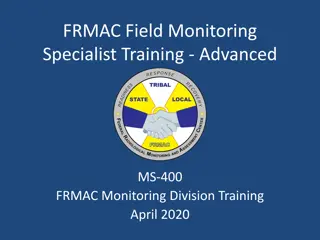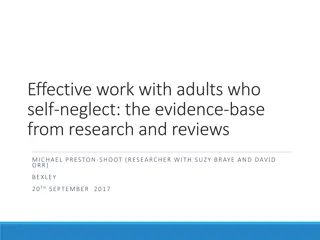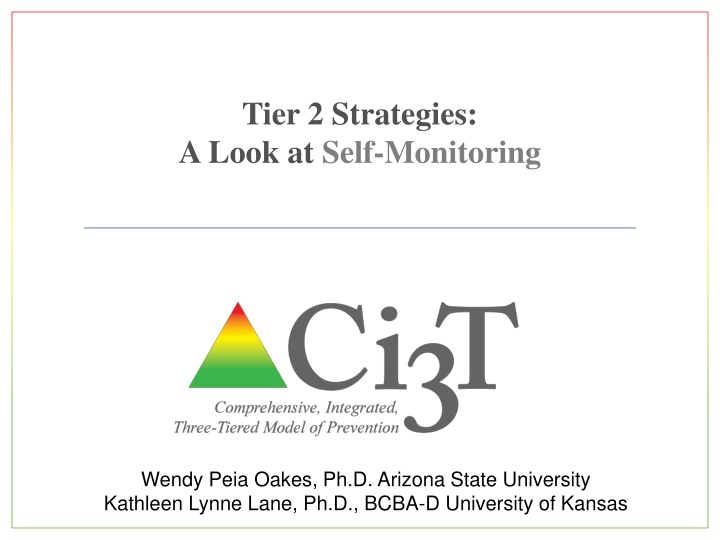
Effective Strategies for Implementing Self-Monitoring in the Classroom
Explore the benefits, challenges, and research supporting the use of self-monitoring as a strategy in the classroom. Learn how to effectively implement self-monitoring to promote independence and improve academic outcomes for students.
Download Presentation

Please find below an Image/Link to download the presentation.
The content on the website is provided AS IS for your information and personal use only. It may not be sold, licensed, or shared on other websites without obtaining consent from the author. If you encounter any issues during the download, it is possible that the publisher has removed the file from their server.
You are allowed to download the files provided on this website for personal or commercial use, subject to the condition that they are used lawfully. All files are the property of their respective owners.
The content on the website is provided AS IS for your information and personal use only. It may not be sold, licensed, or shared on other websites without obtaining consent from the author.
E N D
Presentation Transcript
Tier 2 Strategies: A Look at Self-Monitoring Wendy Peia Oakes, Ph.D. Arizona State University Kathleen Lynne Lane, Ph.D., BCBA-D University of Kansas
Agenda Comprehensive, Integrated, Three-Tiered (Ci3T) Models of Prevention A look at Self-Monitoring What is self-monitoring? Why is self-monitoring effective? What does the supporting research for self-monitoring say? What are the benefits and challenges? How do I implement self-monitoring in my classroom? Implementation Checklist How well is it working? Examining the Effects
Comprehensive, Integrated, Three-Tiered Model of Prevention (Lane, Kalberg, & Menzies, 2009) Goal: Reduce Harm Specialized Individual Systems for Students with High-Risk Tertiary Prevention (Tier 3) Goal: Reverse Harm Specialized Group Systems for Students At-Risk Secondary Prevention (Tier 2) PBIS Framework Goal: Prevent Harm School/Classroom-Wide Systems for All Students, Staff, & Settings Validated Curricula Primary Prevention (Tier 1) Social Academic Behavioral
Monitoring Progress Experimental Design Treatment Integrity Social Validity Is it What do stakeholders think about the goals, procedures, How well did this support work for happening? this and student? outcomes?
A Look at: Self-Monitoring Chapter 6
What is self-monitoring? One commonly used self- management strategy Involves teaching students to: Observe, or determine if a behavior occurred using an operational definition Record whether or not the behavior occurred
Why is self-monitoring effective? Easy Convenient High social validity (students like it) Promotes independency and self- determined behaviors Impacts behavior and academic components
An Overview of Supporting Research on Self-Monitoring Self-management strategies are empirically supported across general education, self-contained special education, and resource classrooms (Briesch & Chafouleas, 2009) Most commonly used self-management strategy for supporting students with emotional and behavioral disorders (Mooney et al., 2005) Generally favorable outcomes in improving academic skills Students with emotional and behavioral disorders showed improvements in specific, targeted academic skills Gains generalized and maintained (Mooney et al., 2005)
What does the supporting research for self-monitoring say? Self-management interventions are an evidence-based practice for improving the classroom conduct of students with challenging behaviors (Maggin, Briesch, & Chafouleas, 2012) Elementary (Levendoski & Cartledge, 2000) Increased on-task behavior and academic productivity High social validity for students Middle School (Carr & Punzo, 1993) Improved academic accuracy, productivity, and engagement for middle school students with EBD High social validity for students
Supporting Research See Self-Monitoring Resource Guide in the Resources folder for additional supporting research and information.
What are the benefits and challenges? Benefits Can positively impact behavior, productivity, and accuracy Empower students to become more independent and self- sufficient in their ability to regulate their environment Challenges Not appropriate for acquisition deficits, self- injurious, or aggressive behaviors
How do I implement self-monitoring in my classroom? Step 1 Establish prerequisite conditions Identify and operationally define the behaviors Step 2 Design the self-monitoring procedures, including a monitoring form Step 3
How do I implement self-monitoring in my classroom? Step 4 Teach the self-monitoring procedures Step 5 Monitor student progress Step 6 Consider maintenance and follow-up
Implementing Self-Monitoring in Your Classroom: Implementation Checklist Step 1: Establish Prerequisite Conditions Step 2: Identify and Operationally Define the Behaviors Step 3: Design the Self-Monitoring Procedures, Including a Monitoring Form Step 4: Teach the Self-Monitoring Procedures Step 5: Monitor Student Progress Step 6: Consider Maintenance and Follow-Up See Implementation folder for Self-Monitoring Implementation Checklist
Self-Monitoring Procedures Step 1: Establish Prerequisite Conditions Target and replacement (i.e., desired) behaviors are readily observable and easy for the student to record The student is capable of performing the replacement behavior If the student has an acquisition deficit, instead teach the replacement behavior The student can control the behavior If the behavior is out of control, a higher intensity intervention should be implemented first The problem behavior occurs frequently See Resources folder: Design A Self-Monitoring Plan
Self-Monitoring Procedures Step 2: Identify and Operationally Define the Behaviors Operationally define the behavior you want to change Provide examples of the behavior Provide non-examples of the behavior
Self-Monitoring Procedures Sample Operational definition Academic engagement during silent reading The amount of time spent actively engaged in silently reading appropriate material Examples include: looking at the book or other reading materials, looking away to think about material for a duration of less than 15 s, appropriately asking the teacher about a word. Non-examples include: any activity other than reading the appropriate material, such as disruptive (e.g., audible vocalizations inappropriate to the assigned task, stomping feet) and off task (e.g., walking around the classroom, looking away from book for more than 15 s, reading an unapproved video game manual) behaviors.
Will you please . Choose a behavior you want to change 1. Label the behavior 2. Operationally define the behavior 3. Provide examples of the behavior 4. Provide non-examples Let s talk
Self-Monitoring Procedures Step 3: Design the Self-Monitoring Procedures, Including a Monitoring Form Create an implementation checklist of procedures Create a student self-monitoring checklist age appropriate explicitly states behavioral goals divided into appropriate times and situations simple Consider including a reinforcement contingency (i.e., If you do X , then you get Y ) to set students up for success
Example: Daily Self- Monitoring Checklist for Work Completion and Accuracy See Implementation folder for Self-Monitoring Secondary Sample Checklist
Example: Daily Self-Monitoring Checklist See Implementation folder for Self-Monitoring Secondary Sample Checklist See Implementation folder for Self-Monitoring Elementary Sample Checklist
Will you please . Design the Self-Monitoring Procedures 1. Daily procedures checklist 2. Self-monitoring form 3. Data collection sheet 4. Reinforcement contingency Let s talk
Self-Monitoring Procedures Step 4: Teach the Self-Monitoring Procedures Teach the student how to use the data-collection sheet Discussion Modeling Coaching Role play Gradually fade adult/teacher support as the student is more comfortable self-monitoring independently Make it clear this is not punishment, but a tool to achieve success
Self-Monitoring Procedures Step 5: Monitor Student Progress Take data on current performance (before the intervention is put into place; baseline data) if you are taking data on the target behavior Implement the intervention and compare intervention data to baseline data Monitor and reward accuracy of student s self- recording by filling out the same form for the same time period Have the student graph their own data to visually see progress
Example: Student Self-monitoring Checklist See Implementation folder for Self-Monitoring Elementary Sample Checklist
On-task Reading Student Outcomes 100 90 80 70 Percentage 60 Student Teacher 50 40 30 20 10 0 Monday Tuesday Wednesday Thursday Friday
Example: Daily Self-Monitoring Checklist for Work Completion See Implementation folder for Self-Monitoring Secondary Sample Checklist
Accuracy of Math Homework Completion Percentage
Self-Monitoring Procedures Step 6: Consider Maintenance and Follow-Up Gradually fade self-monitoring support and data collection once student has consistently improved behavior Options: increase intervals between checkpoints, matching to teacher less frequently, self-monitoring during fewer periods of time each day Note: the student may elect to use the self-monitoring independently as a continued support Ultimate goal is for students to no longer exhibit the problem behavior and maintain the replacement behavior across all settings Once faded, continue to use intermittent behavior-specific praise and reinforcement
How well is it working? Examining the Effects Experimental Design Treatment Integrity Social Validity Is it What do stakeholders think about the goals, procedures, How well did this support work for happening? this and student? outcomes?
Treatment Integrity Have structures in place to monitor whether self- monitoring is carried out as intended Treatment integrity checklist Example questions: 1. Student completed self- monitoring checklist 2. Teacher completed self- monitoring checklist 3. Teacher checked student response to verify accuracy 4. Teacher provided student with feedback regarding behavior 5. Teacher provided student with reinforcer if earned See Implementation folder for Self-Monitoring Treatment Integrity Checklist
What do they think about it? Intervention Rating Profile (IRP-15) Completed by the teacher and/or parent participating in the intervention at two time points: Pre and post intervention See Implementation folder for Social Validity Adapted IRP15_Pre/ Post_ Teacher
What do they think about it? Children s Intervention Rating Profile (CIRP) Completed by the student participating in the intervention at two time points: Pre and Post Intervention See Implementation folder for Social Validity Adapted CIRP_Pre/Post_Student Pre and Post Versions
Sample Elementary Intervention Grid Support Description School-wide Data: Entry Criteria Behavior: SRSS-E7 score: Moderate (4-8) SRSS-I5 score: Moderate (2-3) or SRSS-E7 score: High (9-21) SRSS-I5 score: High (4-15) or 2 or more office discipline referrals (ODR) AND/OR Academic: Progress report: 1 or more course failures or AIMSweb: intensive or strategic level (math or reading) or Progress report: Targeted for Growth for academic learning behaviors Data to Monitor Progress Work completion and accuracy of the academic area of concern (or target behavior named in the self-monitoring plan) Exit Criteria SRSS-E7 score: Low (1-3) SRSS-I5 score: Low (1-2) Self- monitoring Strategy implemented by student and teacher to improve academic performance (completion/ accuracy), academic behavior, or other target behavior. Passing grade on progress report or report card in the academic area of concern (or target behavior named in the self- monitoring plan) Grades on progress reports Social Validity: Teacher: IRP-15 Student: CIRP Treatment Integrity: Implementation & treatment integrity checklist
Sample Secondary Intervention Grid Support Description School-wide Data: Entry Criteria Behavior: SRSS-E7 score: Moderate (4-8) or SRSS-E7 score: High (9-21) or 2 or more office discipline referrals (ODR) or Skyward: 2 or more missing assignments Data to Monitor Progress Work completion and accuracy of the academic area of concern (or target behavior named in the self- monitoring plan) Exit Criteria SRSS-E7 score: Low (1-3) Self- monitoring Strategy implemented by student and teacher to improve academic performance (completion/ accuracy), academic behavior, or other target behavior. Passing grade on progress report or report card in the academic area of concern (or target behavior named in the self- monitoring plan) Passing grades on progress reports AND/ OR Social Validity: Teacher: IRP-15 Student: CIRP Academic: Report card: 1 or more course failures or AIMSweb: intensive or strategic level (math or reading) or Below 2.5 GPA Treatment Integrity: Implementation & treatment integrity checklist
Recommended Resources Questions: wendy.oakes@asu.edu kathleen.lane@ku.edu Lane, K. L., Menzies, H. M., Bruhn, A.L., & Crnobori, M. (2011). Managing Challenging Behaviors in Schools: Research-Based Strategies That Work. New York, NY: Guilford Press. Lane, K. L., Menzies, H. M., Ennis, R. P., & Oakes, W. P. (2015). Supporting behavior for school success: A step-by-step guide to key strategies. New York, NY: Guilford Press.
Recommended Resources Designing, Implementing, and Evaluating Comprehensive, Integrated, Three-Tiered (Ci3T) Models of Prevention: Step by Step Guide (2014). A special issue of Preventing School Failure, volume 58, issue 3 www.tandfonline.com/toc/vpsf20/58/3 Umbreit, J., Ferro, J. B., Liaupsin, C. J., & Lane, K. L. (2007). Functional behavioral assessment and function-based intervention: An effective, practical approach. New York, NY: Pearson.




